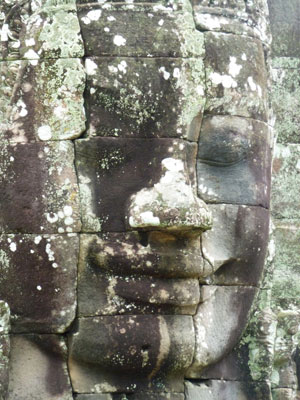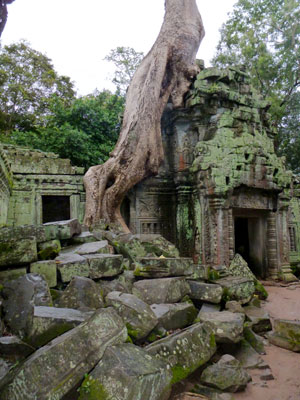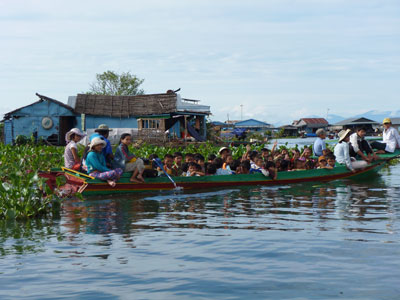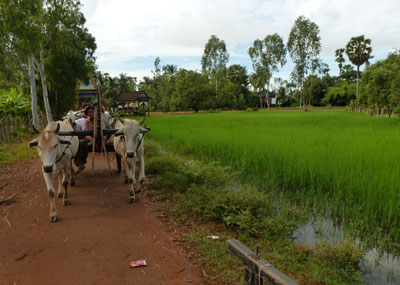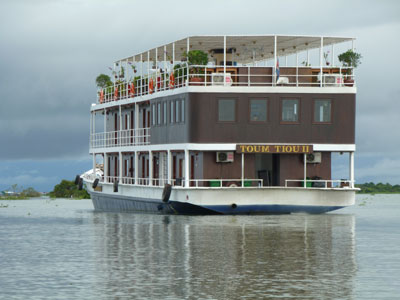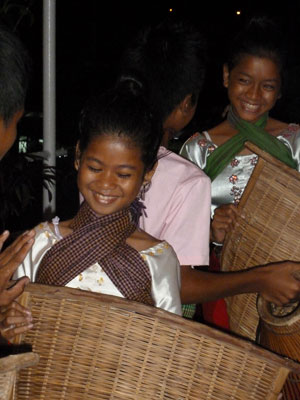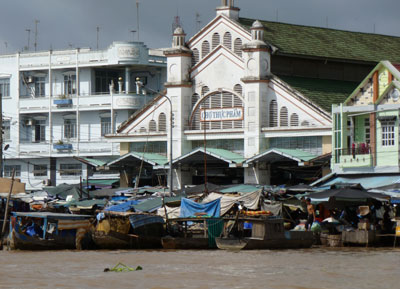Exploring the Mekong River Delta — by land and water
by Beth Habian; Features Editor When traveling to a new destination, I try to take in my surroundings with all of my senses, but sometimes I create a particular sensory association with a country that, when triggered, can transport me immediately back to that place. When I smell the controlled burn of a field, it reminds me of India; tasting the nutty, sweet tang of an imported Parmigiano-Reggiano brings back memories of amazing meals in Italy, and experiencing the thundering crash of a waterfall makes me think of Iceland’s incredible natural beauty. But not until my October ’11 visit to Southeast Asia did a trip come with a soundtrack. However, it wasn’t the ping of a plucked string instrument or the tinny, lilting voice one would generally associate with traditional Asian music that popped into my head. It was pop music from the ’80s and ’90s! Before I even made it from Bangkok’s Suvarnabhumi Airport to the lovely Century Park Hotel for the night, C+C Music Factory’s “Gonna Make You Sweat” started running through my mind. A few days later, while climbing the stairs of Cambodia’s Angkor Wat, it was Buster Poindexter singing “Hot! Hot! Hot!” By the time we reached Saigon, Billy Idol was sneering the words to “Hot in the City.” While the actual temperature was not much hotter than I was used to, the humidity was a killer. I quickly resigned myself to the fact that by the end of each touring day (okay, truthfully, it was by mid morning) I’d be a sweaty mess. But it didn’t really matter; the rest of my senses were starting to have a really good time.
Beginning in Bangkok
My 12-day Mekong Delta cruise-tour, hosted by Value World Tours (Fountain Valley, CA; 800/795-1633), began with an overnight pre-trip stay in Bangkok. Arriving at night was perfect; I was able to go directly to sleep, worn out from the long flight from Los Angeles, and wake up refreshed the next day for a half-day tour of the city.
My impression of Bangkok is a visual one. From the spectacular shades of the huge bunches of orchids filling the Flower Market to the hot-pink, construction-cone-orange and Kelly-green taxis, it is a city bursting with color. The capital is also home to a couple of record-breaking Buddhas. At Wat Pho (which happens to be the city’s oldest and biggest Buddhist temple), we saw Thailand’s largest reclining Buddha — a pretty amazing sight, I must say. The temple housing the statue was quite crowded, but, venturing off to the other small temples in the complex, I found it remarkable how quiet the rest of this place was. Wat Pho is also known as the birthplace of Thai massage and is home to the Wat Pho Thai Massage Medical School. Courses are open to the public, no experience necessary. Ranging from a five-day course (7,500 baht, or $244) to a 26-day professional program (just under $1,000) taught at a separate campus, classes are conducted in English. Wat Traimit, sheltering the world’s largest solid-gold statue of Buddha, seemed to appear out of nowhere. One turn off a busy, shop-lined street and — Bang! — an intricately carved, gilded spire reaches toward the sky. The friendly guide from Asian Trails, the local operator used by Value World, was wonderful, answering all questions asked and sharing useful tidbits about the city while we slowly inched our way through the chaotic traffic. Since we were passing a great number of tourists cruising the city by tuk-tuk, I was surprised when he warned against hiring such transportation in Bangkok. It seems that, there, many of these auto rickshaws run on propane — not the safest fuel choice should one be involved in a collision. After visiting a few more sites, including the glittering, golden complex of the Grand Palace, we were off to the airport for a flight to Siem Reap, where the tour would officially begin.
Continuing to Cambodia
This departure was actually the reverse itinerary of Value World’s Mekong tour, and I initially wondered if traveling in this direction was the best choice, as the tour started with what I considered the main attraction of this trip: Angkor Wat. Wouldn’t it be better as the grand finale?
Perhaps. But seeing that imposing stone structure peaking out from beyond the trees as our group approached sure did grab my attention! My camera never stopped clicking. It was a wonderful way to kick off the tour. We then moved on to Angkor Thom and, within this ancient city’s walls, Bayon. I found this temple impressive — smaller in scale than the sprawling Angkor Wat but, to me, more architecturally interesting. The fact that there weren’t many visitors other than our group of 22 enhanced the experience as we climbed the stairs to get a closer look at some of the 216 faces of Buddha smiling down serenely from the temple walls. Just when I thought the day couldn’t get any better, we were given a surprise. Not on our original itinerary, the “jungle temple” of Ta Prohm would be our final site of the day. Closed shortly before our visit due to flooding, the temple was again open and our guide decided it was worth a stop. I’m so glad he did! Neglected for centuries, this temple has been minimally restored, the grasping trunks of trees still intertwined with the crumbling stone buildings. While there is continuing debate as to whether the site should be fully restored or left as is, walking through this place as the rain started to fall, the mist turning the moss covering the gray stones a vibrant green, turned out to be the highlight of my day. The night ended with dinner at Champey, located next to Siem Reap’s Old Market. The restaurant prides itself on preparing food to Western standards and using purified water (including for its ice cubes). Here we enjoyed a selection of traditional Khmer dishes, all of which I found quite tasty.
Water, water everywhere
The next day we were to board our ship for a seven-night cruise down the Mekong, but first there was a scheduled stop at the Artisans d’Angkor crafts center. The center is an offshoot of the Chantiers-Écoles training school, established to give young Cambodians from poor, rural communities, many of whom have physical disabilities, the skills to create traditional handicrafts. Our tour of the center, showing us the different processes they used in creating works of art, was definitely worthwhile.
The on-site shop was filled with wonderful, quality examples of stone, wood, lacquer and silk work in addition to other local products. I was able to get gifts for all of my friends and family in one shot. Of course, you can probably get souvenirs for less money at many of the markets throughout the country, though not of this caliber, but I found the products here to be very reasonably priced. Unlike at the markets, prices at the crafts center were fixed, saving me the uncomfortable experience of haggling with the seller — something at which I have no talent — and we were left to leisurely browse without employees trying for the hard sell. After lunch, we headed out to the port for the transfer to the Toum Tiou II, our home for the next week. Leaving the center of town, the bus was soon plowing through water, as floodwaters had started to flow into Siem Reap. Kudos must be given to our driver, who skillfully navigated the inundated, potholed streets, passing locals who casually waded knee-deep through the water or sat in streetside cafés, their legs immersed. Later in the tour, as our small ship continued toward Vietnam as scheduled, we passed a number of vessels larger than ours that were unable to continue their travels upriver toward Siem Reap because, with the elevated water level, they could not pass under the bridges.
The ship
Launched in 2008, the Toum Tiou II holds only 28 passengers, all in outside cabins. With its crew of 15, there was always someone nearby ready to offer assistance or just a friendly smile. Because of the ship’s size, cruising on the Toum Tiou II almost felt like spending a week sailing with friends on a boat chartered just for you. It offered a comfortable, relaxed atmosphere in which you could choose to hang out on the sundeck, have a cool drink and watch the beautiful scenery go by or join one of the scheduled excursions for the day, depending on your mood. However, because it is such an intimate setting, it’s “fingers crossed” that your group members are compatible (as ours were), since it’s not really possible to disappear in the crowd.
I found my teak-lined, air-conditioned cabin to be perfectly comfortable (though, as in much of Asia, the beds were quite firm), but I did have the twin-bedded space to myself. With two people, it might be a bit cozy — a good thing or a bad thing, depending on with whom you’re traveling. However, I really didn’t spend much time in my cabin. Instead, when we had free time on board, I enjoyed chatting with fellow passengers or reading in the covered, open-air lounge. Each cabin included a compartment under each bed to store a suitcase, plus a couple drawers, a safe for valuables and a wardrobe for hanging clothes. The bathroom, to me, was surprisingly roomy for such a small ship, especially the shower space. However, some of the taller passengers mentioned that the overhead rainfall showerhead was a little close for comfort, though there was a handheld showerhead available as well. I never had a problem having enough hot water, but some of the others did mention having to settle for lukewarm once or twice. Noise from the ship’s motor and the buzz of nearby fishing boats might be an issue for light sleepers, but I slept with earplugs and was never bothered. However, if you have a choice, you might want to avoid Room 13, even if you’re not superstitious. The couple staying there commented on the early-morning clanging of pots during the breakfast prep and a sometimes-smoky room when meals were being prepared, as that room is directly next to the kitchen. There is a computer on board for guests’ use. Internet access is intermittent, but it’s nice to have the opportunity to stay in touch without having to drag along your own laptop. All in all, I really enjoyed my time on the ship. Meals were always good, offering a variety of selections and featuring both Western and Khmer cuisine. Now that I’m back home, I really miss the fresh, tropical fruits available at every meal, not to mention the always-refreshing drinks served with an ice-cold towel and a “Welcome back!” upon our return to the ship after every excursion.
Cambodia versus Vietnam
I had always wanted to visit Vietnam, but I must admit that Cambodia didn’t come to mind when dreaming of what part of the world I’d like to explore next. I left for this trip with no particular expectations, but I loved, loved, loved Cambodia. In addition to its genuinely charming people exuding an amazing positivity — especially incredible if you consider what they have been through in the not-so-distant past — there is a vibe there that I found very peaceful. When life gets crazy, I’ve often joked that I need to run away to a Buddhist monastery to find some tranquility. Now I know just where to run. Our Cruise Director, Sam, who speaks Khmer, did double-duty as our guide for this portion of the cruise (except for our stop in Phnom Penh). A French-Swiss transplant living in Cambodia, he had a laid-back style and was always available, efficiently handling any issues or questions that came up. Our first excursion, cruising on two small boats through the floating village of Chnok Trou on Tonlé Sap Lake, was enlightening. While some passengers returned to the ship that day commenting on the level of poverty they observed in this village of fishermen, I came away with a completely different impression. Yes, this way of life is unlike what many are used to in the US, but I felt a great sense of community there. Grandmothers called their grandchildren out to wave at our passing boats, all smiles, and people chatted on the front porches of their brightly colored floating houses. It didn’t feel at all, to me, like a depressing place to be. One of my favorite days included a visit to an often-overlooked pagoda in Kampong Tralach, but it was the ride there more than the site we visited that made this excursion most memorable.
Sitting on the floor of a flat-bottomed wooden boat, we passed bright-pink lotuses floating on the water as we headed to shore. We then boarded ox carts, two people per vehicle, for a ride past emerald-green rice fields. (Sounds a bit touristy on paper, but it was fun.) Later we arrived to the sound of cheering children for our visit to an elemetary school. When we crossed the border into Vietnam, things became noticeably different. There was a lot more industrial river traffic and more construction, and the sky went from a pretty blue to a hazy gray. On our first outing in Vietnam, at Chau Doc, we visited a Cham-minority village and were met by a group of really aggressive children selling sweets. While we had encountered children in Cambodia who sold goods with particular zeal, this felt different; it was a jarring introduction. The rest of the sites visited that day were probably the least interesting of the 12-day tour, and if you wanted to spend some extra time relaxing on the ship, this is the day I’d pick to do it. Still turned off by our previous day’s excursion, many in the group decided to skip the next day ashore, but it actually turned out to be quite nice — sampling local fruit and gliding along quiet waterways in a covered boat — as did our remaining touring days in Vietnam.
Saigon
Our cruise came to an end in Saigon (Ho Chi Minh City), and we reluctantly left our floating home. Back on land, our day-long tour began with a drive to the Cu Chi Tunnels. This was the first place where I felt like a “tourist,” the attraction being packed with people, but our guide did a good job of avoiding the crowds. This was not a “fun” visit, but it was perhaps a necessary reminder of what human beings are capable of doing to each other (just as our visit to the Tuol Sleng Museum of Genocide in Phnom Penh had been). The most disturbing part, for me, was walking through the trees looking at barbaric booby traps while hearing, all around me, the sounds of gunfire coming from the on-site shooting range. Then it was back to the scooter-filled streets of the city for a look at some of the major landmarks, including the post office built by Gustav Eiffel. We ended the day at the five-star Hotel Equatorial, where we enjoyed a truly wonderful buffet dinner at Chit Chat at the Café, located on the hotel’s ground floor, before saying good-bye to newfound friends on our final night of the tour.
The details
Value World Tours offers their Mekong Delta program, which I can wholeheartedly recommend, from October to March. The 2012 cruise-tour costs $2,199-$2,499 per person, double, depending on departure, and includes all accommodation, most meals, land transportation, site entry fees and unlimited bottled water (which you’ll need!). Not included are international air (though it can be booked for you), port and fuel surcharges ($110) and visa fees. A one-night pre- or post-trip stay in Bangkok, which eases the transition to the new time zone, costs an additional $120 per person, including hotel with breakfast and a half-day city tour. The flight from Bangkok to Siem Reap adds another $280 per person.
Value World also offers a Cambodia-only tour, which takes advantage of the higher waters at the beginning of the season, allowing the ship to travel to Kratie in search of freshwater Irrawaddy dolphins. This 12-day tour, with limited departures in August and September, costs $1,699-$1,999 per person, double. Visas for Cambodia can be obtained upon entering the country. At the time of my arrival, the cost was $20 per person. Visas for Vietnam need to be arranged before departure. Value World can handle them for you (currently at a cost of $125 per person) or you can use an agency, but I had no problem applying directly through the embassy (1233 20th St. NW, Ste. 400, Washington, DC 20036; 202/861-0737). Applications can be found online, but you must call for current fees. (I paid $80 for a one-month tourist visa.) I had my passport back in my hands within a week. One caveat — when filling out the travel dates for your visa, give yourself a few days leeway before and after your expected travel date to avoid any issues. I inserted the exact date that, according to my itinerary, we would cross into Vietnam. However, once I arrived on the ship, I was told that it should have been dated one day earlier. Luckily, Sam collected our passports at the beginning of the cruise and checked all visas, discovering that mine, along with three others, had invalid dates. He spent a day scrambling to have the problem rectified, for which I am extremely thankful, but I did need to pay an additional visa fee for my mistake.
A few last thoughts
Travel in Cambodia is made more convenient by their use of the US dollar. There was no need to exchange money or do conversions in your head. Not only do merchants accept dollars but prices are marked in US currency as well. In Vietnam, all prices were marked in dong, but dollars were accepted. I usually try to learn a few words of the language before I travel to a new country, so, since I thought Vietnamese would be the easier language to find an instructional CD on, I chose Pimsleur’s “Quick & Simple Vietnamese.” I never made it past the first phrase! As with a number of Asian languages, intonation is key in the proper pronunciation of Vietnamese. After listening to that first phrase over and over, I started worrying that if I got the emphasis wrong, I might end up insulting people rather than, say, thanking them, so I gave up. I learned, once on my trip, that the language I should have given a shot was Khmer. This is not a tonal language and, while I have no delusions that it would have been easy, perhaps I would have had a fighting chance.
Preparing for your visit
If you’re interested in joining Value World’s tour of Cambodia and Vietnam, I have a few suggestions that I hope are helpful. Pack a handheld fan or buy one once you arrive. One made of fabric rather than paper would be the smarter choice, considering the humidity.
I had thought about packing my tiny, battery-powered fan before deciding that I was being silly, but when I saw another traveler with one on a particularly hot day, for just a second I had murderous thoughts about how to get it away from him. Malaria pills were not required for this area, but bug repellent is a good idea, as is a decent sunscreen. For temple visits, be sure to pack a shirt that covers your shoulders and a skirt or pair of pants that comes below your knees. In Bangkok, it was necessary to be covered to the ankle to visit the Grand Palace. Good walking shoes are a must. Though there isn’t a huge amount of walking on this trip — except for the day at the Angkor temples — surfaces are often uneven and sometimes slippery. The tour, including the cruise, is completely casual, so there’s no need to pack anything ultrafancy. Laundry service on the ship was inexpensive and quick, which was great, since the humidity nixed the idea of washing and drying anything, yourself. A couple of the guests reported that it took an average of two days for a pair of underwear to dry! Most important, take an open mind. Once you get there, your joyful smile should appear automatically. Beth was a guest of Value World Tours.


